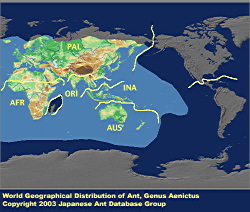
|
genus
|
Aenictus
|
 |
Japanese Name
|
Hime-sasurai-ari-zoku
|
Original Reference
|
|
Shuckard, W.E. (1840) Monograph of the Dorylidae, a family of the Hymenoptera Heterogyna. (Continued from p. 201.) Annals of Natural History; or Magazine of Zoology, Botany and Geology 5: 258-271.
|
Description
|
|
Medium to small ants. Color yellowish brown to reddish brown; eyeless; antennae 8- to 10-segmented; promesonotal suture obscure or lacking on mesosomal dorsum; metanotal groove more or less distinctly impressed dorsally; gastral pedicel consisting of 2 segments.
|
|

|
Remarks
|
|
These army ants invade the nests of other ants and prey upon their larvae and pupae. Males are attracted to lights at night, and are thus often taken by collectors. As a result a number of named species have been described from male type specimens. About 110 species have been recognized, many of them are distributed in subtropical and tropical Asia, including India and southeast Asia (Wilson, 1964). Two species are known from the Nansei Islands in Japan.
|
References
|
|
- Monograph of the Dorylidae, a family of the Hymenoptera Heterogyna. (Continued from p. 201.) Annals of Natural History; or Magazine of Zoology, Botany and Geology 5: 258-271.
- Wilson, E. O. (1964). The true army ants of the Indo-Australian Area (Hymenoptera: Formicidae: Dorylinae). . Pac. Ins., 6, 427-483.
|
Editor
|
|
Original text and English translation by Mamoru Terayama, edited by Kazuo Ogata and Robert W. Taylor.
|
|